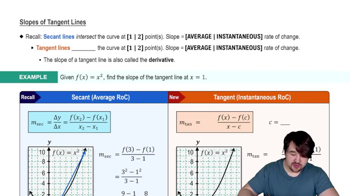Table of contents
- 0. Functions7h 52m
- Introduction to Functions16m
- Piecewise Functions10m
- Properties of Functions9m
- Common Functions1h 8m
- Transformations5m
- Combining Functions27m
- Exponent rules32m
- Exponential Functions28m
- Logarithmic Functions24m
- Properties of Logarithms34m
- Exponential & Logarithmic Equations35m
- Introduction to Trigonometric Functions38m
- Graphs of Trigonometric Functions44m
- Trigonometric Identities47m
- Inverse Trigonometric Functions48m
- 1. Limits and Continuity2h 2m
- 2. Intro to Derivatives1h 33m
- 3. Techniques of Differentiation3h 18m
- 4. Applications of Derivatives2h 38m
- 5. Graphical Applications of Derivatives6h 2m
- 6. Derivatives of Inverse, Exponential, & Logarithmic Functions2h 37m
- 7. Antiderivatives & Indefinite Integrals1h 26m
- 8. Definite Integrals4h 44m
- 9. Graphical Applications of Integrals2h 27m
- 10. Physics Applications of Integrals 2h 22m
6. Derivatives of Inverse, Exponential, & Logarithmic Functions
Derivatives of Inverse Trigonometric Functions
Problem 3.10.3
Textbook Question
Find the slope of the line tangent to the graph of y = tan^−1 x at x= −2.
 Verified step by step guidance
Verified step by step guidance1
First, understand that the slope of the tangent line to the graph of a function at a given point is given by the derivative of the function evaluated at that point.
The function given is y = tan^−1(x), which is the inverse tangent function. We need to find its derivative with respect to x.
The derivative of y = tan^−1(x) is given by the formula: <math xmlns="http://www.w3.org/1998/Math/MathML"><mfrac><mn>1</mn><mrow><msup><mi>x</mi><mn>2</mn></msup><mo>+</mo><mn>1</mn></mrow></mfrac></math>. This formula comes from the differentiation of the inverse tangent function.
Now, substitute x = -2 into the derivative formula to find the slope of the tangent line at this point: <math xmlns="http://www.w3.org/1998/Math/MathML"><mfrac><mn>1</mn><mrow><msup><mo>(</mo><mn>-2</mn><mo>)</mo><mn>2</mn></msup><mo>+</mo><mn>1</mn></mrow></mfrac></math>.
Simplify the expression obtained in the previous step to find the numerical value of the slope. This will give you the slope of the tangent line to the graph at x = -2.
 Verified video answer for a similar problem:
Verified video answer for a similar problem:This video solution was recommended by our tutors as helpful for the problem above
Video duration:
1mPlay a video:
Was this helpful?
Key Concepts
Here are the essential concepts you must grasp in order to answer the question correctly.
Derivative
The derivative of a function at a given point measures the rate at which the function's value changes as its input changes. It is defined as the limit of the average rate of change of the function over an interval as the interval approaches zero. In this context, finding the slope of the tangent line involves calculating the derivative of the function y = tan^−1(x) at the specific point x = -2.
Recommended video:

Derivatives
Tangent Line
A tangent line to a curve at a given point is a straight line that touches the curve at that point without crossing it. The slope of the tangent line represents the instantaneous rate of change of the function at that point. In calculus, the slope of the tangent line can be found using the derivative of the function evaluated at the point of interest.
Recommended video:

Slopes of Tangent Lines
Inverse Trigonometric Functions
Inverse trigonometric functions, such as tan^−1(x), are the functions that reverse the action of the standard trigonometric functions. For example, tan^−1(x) gives the angle whose tangent is x. Understanding the properties and derivatives of these functions is essential for solving problems involving their slopes and behaviors, particularly when calculating derivatives at specific points.
Recommended video:

Derivatives of Other Inverse Trigonometric Functions

 7:26m
7:26mWatch next
Master Derivatives of Inverse Sine & Inverse Cosine with a bite sized video explanation from Callie
Start learning


